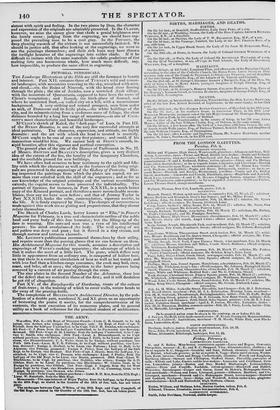PICTORIAL PERIODICALS. PICTORIAL PERIODICALS.
THE Landscape Illustrations of the Bible are still the foremost in beauty and interest. Part XII. contains three of TURNER'S wild and roman- tic landscapes, with mountains towering to the sky, wreathed with mist, and cloud,—viz. the Ruins of Nineveh, with the broad river flowing through the plain ; the site of Jericho, now a wretched Arab village, 'with the mountain of Quarantania, supposed to have been the scene of Christ's temptation ; and Ratnab, the birth-place of Samuel, and where he annointed Saul,—a -.veiled city on a hill, with a mountainous background. A very striking and natural prospect, seen from under an arch, of Damascus and its fetile plain,—the white buildings of the city, and its minarets rising from a verdurous mass of foliage, the clear distance bounded by a long low range of mountains,—is one of CALL- corr's most characteristic and beautiful landscapes.
M'CLisE's sketch of Kaled, the "dark page" of Lain, in Part III. of the BYRON Beauties, is one of the very few successful attempts at ideal portraiture. The character, expression, and attitude, are highly dramatic : and the art with which the head is treated is masterly. M'CusE ought to be one of our very first painters ; and could, if his mannerism would let him. We cannot look at STONE'S smooth, in- sipid beauties, after this vigorous and poetical conception. The ground plan of the site of the Houses of Parliament in No. II. of Messrs. Barr-roN and BRAYLEY'S description, gives a very distinct idea of the extent of the fire, the locality of the temporary Chambers, and the available ground for new buildings. We have often had occasion to bear testimony to the spirit and fide- lity with which the character as well as the features of the living origi- nals are preserved in the engravings of the Gallery ef Portraits. Hav- ing inspected the paintings from which the plates are copied, we arc more than ever satisfied with the skill of the engravers ; and as far as our knowledge of the original paintings and the various resemblances extends, the copyist seems to have preserved the individuality. The portrait of Spenser, for instance, in Part XXXII., is a much better copy of the Kinnoul portrait, and therefore a more reconcileable resem- blance, than any we have seen before ; and that of Jeremy Taylor in Part XX XIII. looks the calm, contemplative, vigorous ascetic, to the life. It is finely engraved by Iloil.. The charges of incorrectness tnade against this work are so glaring and preposterous, that they almost refute themselves.
The Sketch of Charles Lamb, better known as " Elia," in Fraser's Magazine for February, is a true and characteristic outline of the noble head and puny body of this fine humorist; but the filling-up of the face is wanting. His outv.-ard man was a type of his intellectual powers : his mind overbalanced the body. The well.spring of wit and pathos was deep and pure ; but it flowed in a tiny stream, and through narrow and tortuous channels.
Mr. LOUDON'S publications recommend themselves by their utility, and require more than the passing glance that we can bestow on them. .His Architectural Magazine for this month, contains a description and engravings of IVEEKS'a cooking apparatus ; the advantage of which is that it makes the most of a little fuel. The grate, which differs very little in appearance from an ordinary one, is composed of hollow bars, so that there is a constant circulation of heat as well as hot water; and with less fuel than a kitchen-range consumes, the cook may boil, stew, roast, and bake, all at once ; the objection to the latter process being removed by a current of air passing through the oven. The zinc plates in the Second Number of the Arboretum, show less of the defect that we noticed in those of the first; and it will doubtless be got rid of altogether.
Part XV. of the Enqcloptedia of Gardening, treats of the culture of fruit-trees ; in the training of which to cover walls, nature bends to the sway of the pruning-knife.
The completion of BILLINGTON'S Architectural Director, by the pub- lication of a double part, numbered X. and XI. gives us an opportunity of bestowing the praise it merits, for the comprehensiveness of its contents, the neat execution of its numerous plates, and its general utility as a book of reference for the practical student of architecture.























 Previous page
Previous page